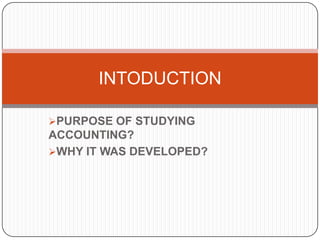
Presentation on history of accounting
- 1. INTODUCTION PURPOSE OF STUDYING ACCOUNTING? WHY IT WAS DEVELOPED?
- 2. Why double entry bookkeeping developed? Key Ingredients Private property Capital Commerce Credit Writing Money
- 3. Accounting in Ancient times Many of these factors did not exist in ancient times, but, until the middle ages, they were not found together in a strength and form necessary to push man to the innovation of double entry writing This made the job of ancient accountant extraordinarily difficult. In societies where all were illiterate, writing material costly, numeration difficult and money system inconsistent, a transaction has to be extremely important to justify keeping an accounting record…
- 4. Which came first?-writing or numbers Number of archeologist believe that writing actually developed out of early marks that were used to tally the kinds and amounts of goods in stock Dr Dreyer discovered that the numerous inscribed bone labels attached to bags of oil and linen in the tomb of king scorpion, Egypt-date back 5300 year.
- 5. One of the oldest profession In the ancient Egypt, the accountant was called the ‘eye and ear’ of the king
- 6. Accounting in MESOPOTAMIA Mesopotamian equivalent of today’s accountant was the scribe He ensured that the agreements compiled with detail code requirements for commercial transactions.
- 7. Simple Token System Simple token system did not require abstract concepts of numbers, writing or money!
- 8. Accounting Predate Writing writing tablet and Economic tablet with numeric signs ( Roman, Mesopotamian, Susa 3200 BC)
- 9. Sealing Tablets This tablet is a receipt for beer, sealed by a clerk
